|
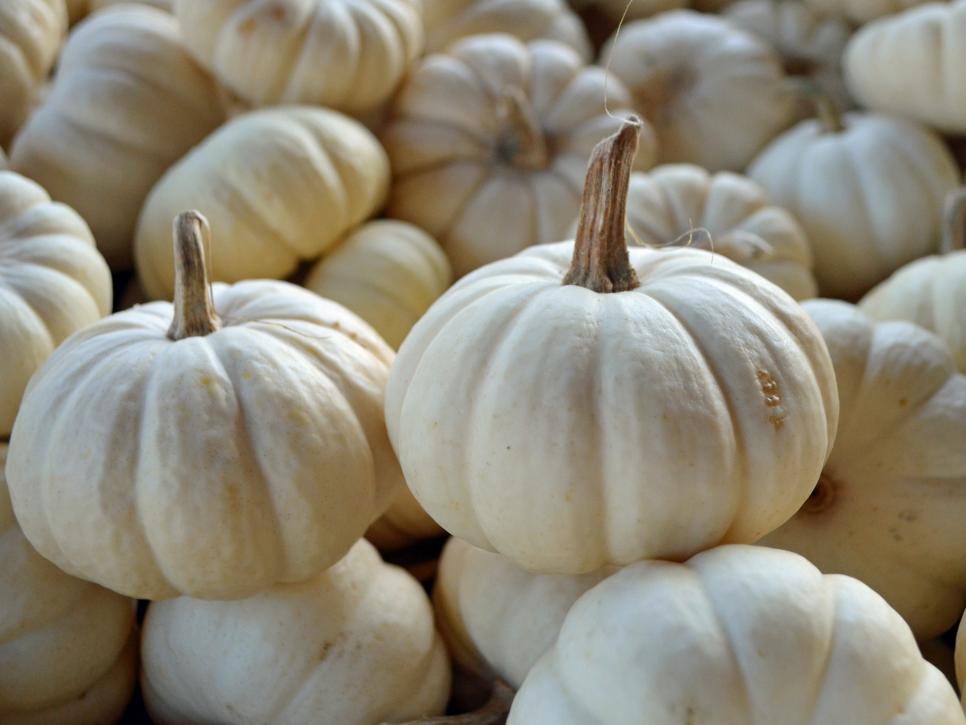
Suitable for savory applications, flavour often too delicate for desserts.
fruit size: 5 to 8 cm in diameter by 2 to 3 cm in height
weight : 100 to 200 grams.
description: Mini pumpkin 5 to 8 cm in diameter and 2 to 3 cm in height.
Pure white color with ivory, very ribbed.
Productive (8 to 20 fruits per foot).
White flesh, not very thick, floury, sweet with a chestnut flavor.
growth: 95 days
use: Stuffed, fried potatoes, desserts.
conservation: 1 year.
Ghostly white to cream coloring with deep ribbing. The White Pumpkin’s average diameter is 2.5 to 3.5 inches and approximately 2 inches high. The white pumpkins comes in a variety of shapes, from flat to rounded. Because of the white color, this pumpkin is only offered in natural. (The wax tends to discolor them).
If not protected from the sun after they have been harvested they turn a soft yellow in color.
Baby Boo, the male parent of the larger, slightly squat Ghost! F1.
Baby Boo Pumpkins were developed by a John Jaunsem of West Milton, Pennsylvania.
Released 1990.
|

Known as Blanc de Mayet, or White of Mayet from Mayet, a city near Le Mans in the Pays de la Loire (North Western France). Very beautiful fruits of cream-white color with orange flesh. Slight ribbing, sometimes with hubbard/turban shaped blossom end. Taste : Firm, unsweetened, rather bland. Usage : Soup, gratin, sauteed, same uses as zucchini
Varieties:
Suceava Big White
From Suceava County, Romania. "In 2014 I was traveling with my girlfriend, Irina Stoenescu throughout her native country of Romania searching the back roads and farms and markets for special finds. For me it was perfect, Irina was kind enough to take all of my enthusiasm and also do all of the translating. In the northern town of Suceava, we came across this beautiful old landrace. It must be noted that in Romania, the countryfolk don’t necessarily get involved in naming their vegetable varieties, so inevitably there were many humorous moments. My so called “Suceava Big White” is one of them. When Irina asked what it was called the old farmer looked at her like she was an idiot..? Even though I could not understand him, he seemed to say; “ What? You don’t know what this is?... it’s a pumpkin!” Actually she persisted, “Yes, of course I know what it is, but what do you call it?” The farmer shouted out (the equivalent) of “It’s a pumpkin!” So, you see on our side a little creative genius is needed, hence the aptly named “ Suceava Big White” a squash/pumpkin… that needed a name. Fruits get to about 15 pounds judging from the farmer’s selection, they are Beautiful deep orange fleshed. Judging from the sounds of it, the fruits take About 100 days, they should thrive anywhere that hubbard types do well."
|
|
Casper Pumpkins are a beautiful vivid white with thick orange flesh of excellent eating quality. They grow to uniform 9-12 inch in diameter.
Casper Pumpkins have smooth, white rind with a bluish tinge at times, though less so than many other white varieties, with a tan coloured handle.
They grow to be 18 to 24 inches (45 to 60 cm) wide by 8 to 10 inches (20 to 25 cm) tall, and weigh 10 to 20 pounds (4 ½ kg to 9 kg.)
They have good tasting, dark-orange flesh. Can be oversweet.
100 days from seed.
Casper Pumpkins were developed by a Jerry Howell of Fonthill, Ontario (near Niagara Falls, Canada.)
One of the parents was a Shamrock Pumpkin.
Released 1992.
Was first called "Blanco."
|
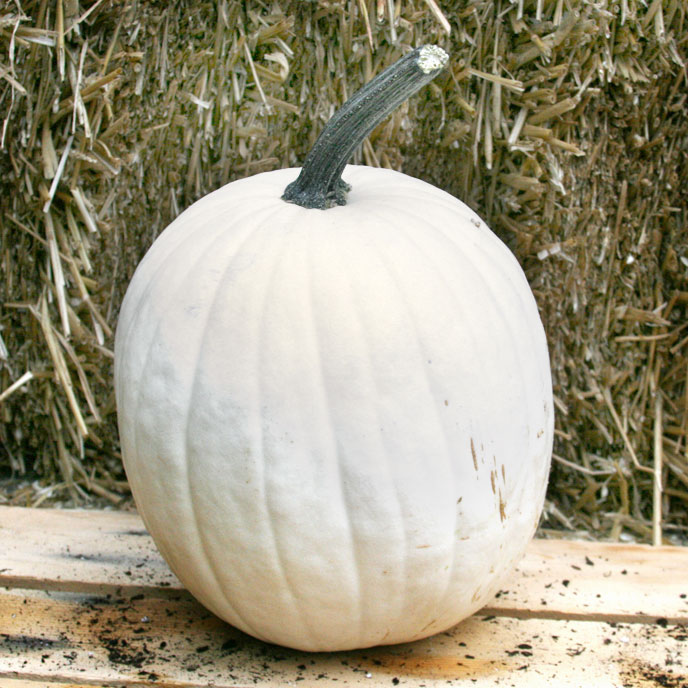
White flesh instead of orange. Suitable for cooking.
White Pepo aka Cotton Candy was introduced to commerce by the Rupp Seed Company of Wauseon, Ohio. It's a nice cream colored pepo type pumpkin (C. pepo) with some intentional variability in size, ideal for farmstand Halloween sales where this novel color introduction displays well beside traditional orange pumpkins. It has tender easily bruised skin (imperfections show up more on the white surface) with white flesh and a large seed cavity suited for carving. It's handle is not firm and long lasting though. The skin can darken exposed to the sun from cream to a creamy yellow color. Although not considered a prime edible squash, the flesh is crisp and can be shredded to make a fresh salad like cabbage slaw. It is generally considered tasteless and like a spaghetti squash (which it might resemble to some), takes on the flavor of the seasoning. There are other white pumpkins commercially available including a few maxima type (C. maxima) pumpkins like "Casper" which are significantly different in characteristics to Cotton Candy.
|
|
Dishpan Cushaw. One foot in diameter but 5-7 inches from stem to blossom end. Orange-fleshed, white skinned fruits are great for pies; excellent keepers.
|
|
A heirloom from South Africa and one of the finest pie and general use pumpkins you can grow.
A very decorative pumpkin as well, it is very large, ribbed, and has a beautiful, unique creamy white color. It stores for a very long time so and has dense smooth creamy sweet orange flesh that is superb for cooking and baking.
Has a strong vine handle, and will easily reach 25 pounds or more. Has large seeds well suited for roasting. 115 days.
It was introduced in the seed bank of the Vavilov Institute in Russia in 1940.
|
|
White flesh, watery not as suitable for cooking.
New Moon Hybrid:
A distinctive white fleshed pumpkin it has the ability to become massive, with average sizes of 25-35 pounds, but treat it just right and you could get an 80 lb. snowball or larger. Producing a uniform size with long firm handles and smooth skin it is great for carving.
Varieties:
Blanche of Dauphiné
Recognized by the very light color of its flesh and its almost white skin.
Origin: French variety of Dauphiné.
Runner: yes Fruit: cream color, round with tendency to flatten. Fruit size: Circumference: 140 cm - Height: 50 cm. Weight: 30kg to 50kg. Epidermis: Thin and tender. Flesh: yellow-orange, very thick, dense, slightly fibrous. Growth: 100 days. Usage: Soups, purees, gratins, soufflés, rice dishes and squash.
Conservation: 3 to 5 months, 8 months in some cases.
|

Also known as White pepo
White flesh, potato like flesh once cooked. (species and photo not confirmed with description)
Is between 10-20 lbs. and offers an spooky, white skin and delicious flesh for cooking.
We crossed Cotton Candy with Baby Boo in 2005 to produce an F1 (Ghost!) which was distributed through the OSP (Organic Seed Partnership) to participating organic farmers in New York State in 2006 and 2007. The diminuative Baby Boo, a patented Jack-Be-Little type with long lasting white skin is a popular fall decorative squash and like Cotton Candy is an open-pollinated variety (non hybrid). Cotton Candy and Baby Boo are the parents of the Ghost! tribe that is being trialed through the Organic Seed Partnership. The F1 generation produced a rather squat medium sized white pumpkin which a lot of folks like. This summer the seed from the F1 generation was planted and gave rise to a diverse tribe of interesting pumpkins that I posted pictures of in an earlier rambling. Now the pumpkins have been in the field all summer and we can take a closer look at them.
Ghost! is an easy to make your own hybrid pumpkin since both parents are readily available in commerce. It turns out that the F1 has very good baking qualities probably from Baby Boo, is a long keeper and has a better handle than Cotton Candy
|
|
|
|
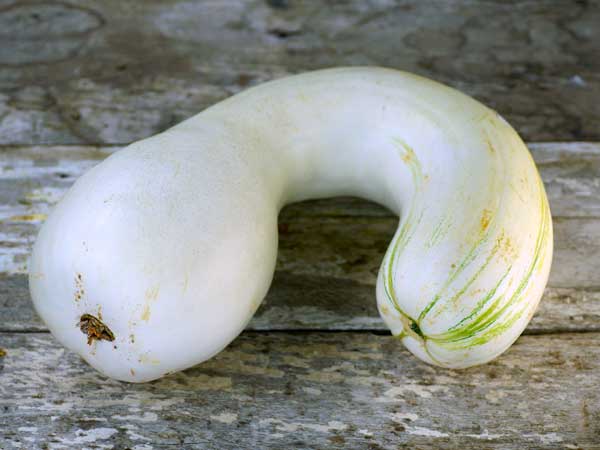
Suitable for cooking.
Also known as White Crookneck Pumpkin. Large white-to-ivory, club-shaped fruits reach 30 inches long and weigh 18-25 lbs. The flesh is pale yellow, and the fruits keep fairly well. The variety was widely grown in southern Illinois, often in cornfields, and was preferred there for pies. Our foundation seed came from collector Kevin McCarty, who writes that the variety was grown continuously on a particular Illinois farm from 1830 to 1980, the original seed having been provided by Abraham Lincoln's parents.
Varieties:
Miller Family Crookneck Squash
A pale green-striped cushaw type originating with one of our growers in Arkansas. The mild-flavored yellow flesh of this variety is heavily favored among members of his Mennonite community for pies; it’s the only one most of them will grow! May have originated as a commercial variety, but the grower’s family have been saving their own seed of this variety for at least three generations. Resists pests and diseases, like all cushaw types. 100 days.
This variety has been grown by the Mennonite communities in Arkansas, USA since the 1950's with the seed saved carefully each year for next seasons crop. It is a cushaw type of pumpkin with a large bulb at the blossom end tapering to a thick meaty neck. The rind is smooth, creamy coloured with faint green stripes. The medium length, thin vine is quick to flower and produce fruit ranging from 3kg to 6kg, or larger, in around 85 days. Inside, the light yellow flesh is medium firm and mildly sweet, making it ideal to use in baking. This variety is also known as "Miller Crookneck" and the Mennonites grew and marketed it under this commercial name.
Jonathan
Also known as White Cushaw.
A rare Cushaw type; white skin and sweet, pale orange flesh. Easy to grow, huge yields, and good resistance to squash bugs. A popular heirloom from the South. (1891)
|
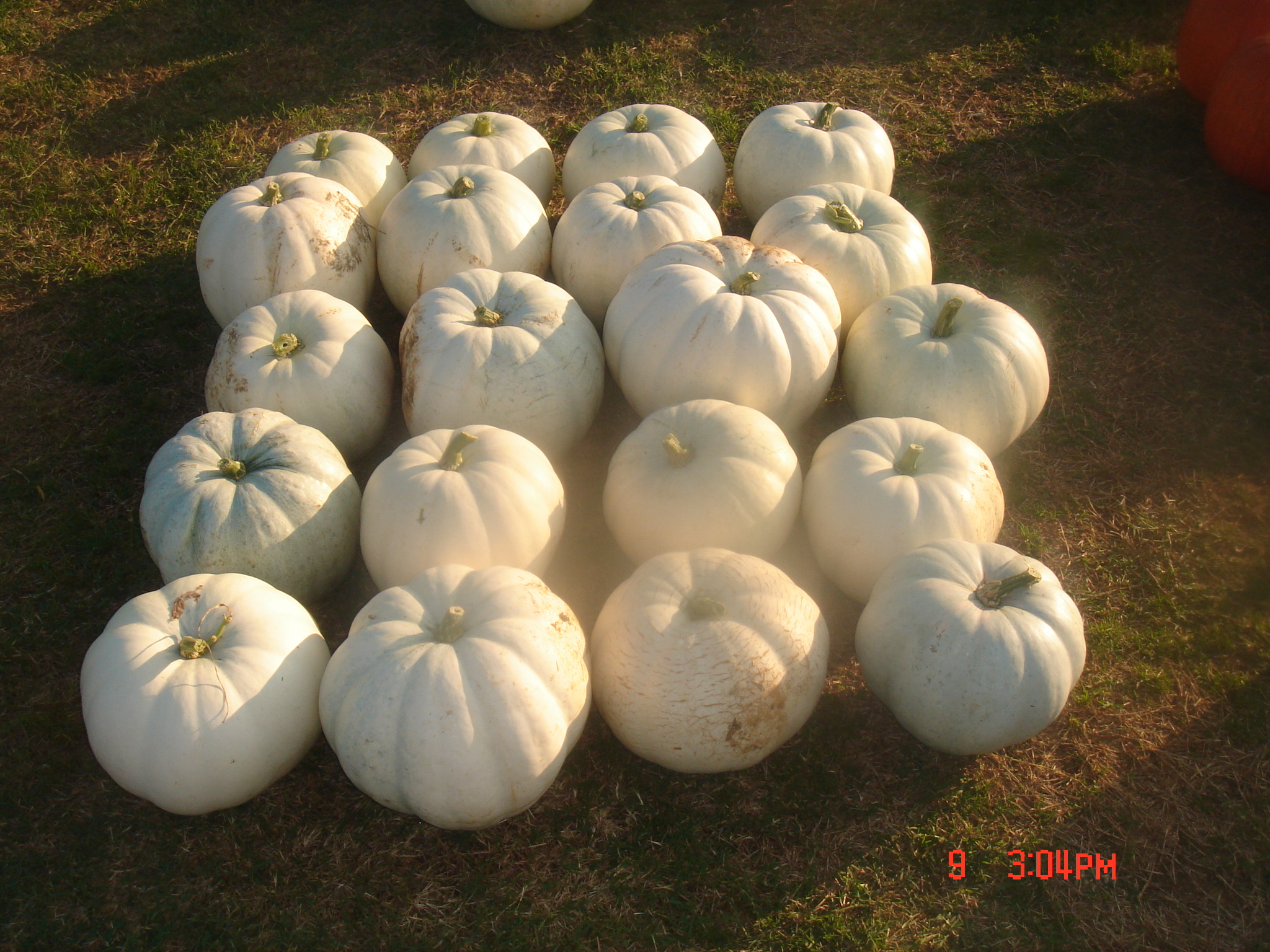
Is between 10-20 lbs. and offers an spooky, white skin and delicious orange flesh for cooking.
Lumina Pumpkins are a ghostly white on the exterior, but have an orange interior flesh. They have a delicious flavor and are excellent baked into a pie. When you bring one home display them out of the full sun so they will last longer and keep their white color.
The satiny texture and sweet pumpkin taste of the Lumina variety is excellent for baking.
Recent variety (1990), resulting from a spontaneous mutation, originating from the United States.
Varieties:
Super Moon F1
Pure white pumpkins
2 – 4 fruits per plant
Matures in 90 days
Hybrid seeds
Enjoy the ghostly white, smooth, clean skins of these medium sized Halloween pumpkins. Plant Super Moon pumpkin seeds in full sun, in fertile soil with enough space to allow the indeterminate five foot long vines to take hold. Expect two to four fruits per plant, each weighing 25-30 lbs, and measuring 38-45cm (15-18″) across. The deep green leaves are tolerant to powdery mildew, and the fruits are early maturing.
|
|
Blanc Du Maroc is a popular market pumpkin variety from Morocco. It is a large variety, with a ribbed acorn shape with smooth rind which starts out light green with lighter markings and matures into a creamy green colour. The vigorous vines, given their origin, love hot weather and will produce fruit from 5kg to 12kg in about 115 days. The very thick yellow/red flesh is soft, moist, smooth and sweet. Because this lovely flesh is very thick and very dense, the fruit are quite heavy for their size.
Excellent, massive pulp. This variety from the Moroccan countryside gets a weight of up to 18 kg (40 lbs). These squashes have pointed ends. Its massive, dark pulp is popular for several dishes. 125 days.
|
|
Also known as Nova Caravela. Popular in Brazil and probably from there.
The New Caravelle Pumpkin is great for making sweets. The bark is cream-colored. The flesh is strong orange and contains no fibers. The shape of the fruits is oblong, with a size between 20 cm and 30 cm in diameter and between 40 cm and 50 cm in length, weighing between 9 and 12 kg. The planting season runs from August to November in the southern region and throughout the year in other regions.
Germination occurs between 4 and 8 days. The cycle is approximately 140 days in the summer. The planting should be done with spacing of 3 mx 3 m. Each gram has 11 seeds, being necessary 400 grams per hectare. The plant is low, strong and vigorous.
Variety:
Jerimum of Milk
It is also known as Jerimum de Leite, Pumpkin Sergipana or Maranhão. It is cultivated mainly in the North and Northeast of Brazil. It is very tasty and great for cooking. They weigh on average 4 to 8 pounds.
|
|
The Quaker Pie Pumpkin was developed among the Quakers of Washington County, New York (hence the name) and then released commercially in 1888 by Philadelphia seedsman W. Atlee Burpee. The original strain featured creamy white skin and weighed as much as 10 to 12 pounds. English Quaker missionaries later took this squash to Africa where it developed into several strains. We acquired the “Mamouza Strain” from Dodoma, Tanzania in 2001 and offer it here for the first time. This sub-variety features off-white somewhat flesh-colored skin and small round fruits weighing no more than 3 to 4 pounds. The flesh is dense, sweet, and has good storage qualities, lasting as long as 6 months. Furthermore the large, over-sized male flowers are ideal for stuffing. Allow 120 days.
Grown for the Roughwood Seed Collection at Field’s Edge Farm, Lititz, Pennsylvania.
|
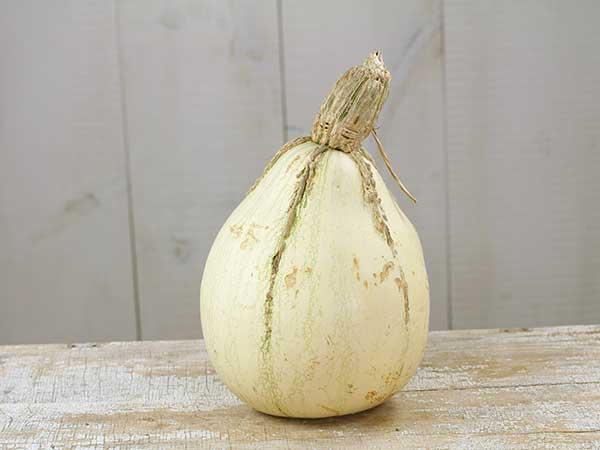
Very popular in seed catalogs from the 19th and early 20th centuries; this variety was then praised as the best for pies among many seedsmen, who had an impressive list of virtues for this squash, such as this 1918 listing from Great Northern Seed Co: "A magnificent pear-shaped variety of fine size, a little ribbed; color creamy white, sometimes striped with green. Has no superior for making pies and custards; when cooked it has somewhat the appearance of sweet potatoes, but of more delicious taste. Flesh thick, creamy white, remarkably fine grained, dry and brittle, hardy and productive and keeps perfectly sound until late in the Spring." We find the above description a little bit of a stretch as far as its pie making qualities and the "better than sweet potato-ness"; however, this type of squash can really be great when fried in a skillet with onions, garlic and a little salt, and they kind of taste like regular potatoes, only more flavorful and delicious. Beautiful, pear-shaped fruit are white with faint green stripes, making this variety very ornamental as well.
Tennessee Sweet Potato Squash is possibly the same squash as that which was listed in 1847 by Grant Thorburn (seed merchant in New York), as "Green Striped Bell."
The "Tennesse Sweet Potato" name seems to have appeared in 1883, and been coined by W. Atlee Burpee Company.
Cucurbita mixta Tennessee Sweet Potato (Scientific Name)
It is said to have first been listed in 1847 by New York seedsman Grant Thorburn as 'Green Striped Bell' and then, most likely re-named by W. Atlee Burpee in 1883[1] to 'Tennessee Sweet Potato'. Other synonyms used over the years include, 'Genesee Sweet Potato', 'Virginia Sweet Potato', and simply, 'Sweet Potato'. Whether it was simply renamed or possibly a selection of the original, this is what Burpee had to say in 1883 and it still holds true today:
"Grows to medium size, pear-shaped, a little ribbed, color creamy white, sometimes lightly striped with green, flesh thick, creamy white, remarkably fine grained, dry and brittle, and of most excellent flavor. Hardy, very productive, and keeps perfectly sound until late in the spring, longer than any other pumpkin. It speedily becomes a general favorite wherever it has been introduced. Has no equal for making pies and custards. When cooked it has somewhat the appearance of sweet potatoes, but of more delicious taste. It proves very distinct and fixed, and is a valuable acquisition. This variety we recommend as being superior to any other variety of pumpkin for cooking purposes in cultivation. Its attractive appearance makes it a specially valuable kind for the market gardener. Our stock of this variety is grown with special care, and cannot fail to give satisfaction to our patrons, but the seed being very scarce, we can sell it only in packets. Do not confound the Tennessee Sweet Potato Pumpkin with any other so-called Sweet Potato Pumpkin."[2]
Sources:
"Vegetables of New York: Vol.1 - Part IV - The Cucurbits," by William T. Tapley, Walter D. Enzie, Glen P. Van Eseltine, 1937.
"Burpee's Farm Annual for the Southern States," 1883.
Varieties:
Fortna White Pumpkin
A unique pear-shaped pumpkin with lovely white skin. The vines give good yields of 10 lb fruits. Creamy yellow flesh makes great pies. An heirloom that has been grown by the Fortna family of Pennsylvania for more than 60 years. Rare and unusual.
Seed reviews:
MD, USA: Pros:Great taste; makes great pies. Cons: none. These pumpkins have been in my family for years and are named for my uncle Wayne Fortna who was famous for them. They make wonderful eating and are easy to grow and prepare. They are a very convenient size, not being tremendously large, and have an unusual white skin with a yellow/orange flesh.
|
|
Snow-white skin.
Is between 10-20 lbs. and offers spooky, white skin and delicious flesh for cooking.
Clearly the whitest pumpkin; unique for doorstep decorations and painting. Medium-size, flattened, avg. 11-15" diam. x 6-8" tall, slightly ribbed, with a smooth white skin. Thick orange flesh suitable for pies. Avg. yield: 2 fruits/plant.
This pumpkin is fun for fall decorating . . . and when you are through it is suitable for pies. It is similar to a Lumina in color, but has the desirable flattened and deeply ribbed style of a Cinderella. The flesh is very light in color - nearly white. Be prepared if you are expecting traditional orange. It makes an unusual looking pie. It can be a bit stringy and often is high in water content, so you might want to consider pureeing it and reducing it before using it in your favorite recipe.
|

The White Swan, White Acorn or Swan White acorn squash when mature is hard and encased in a thin creamy white to pale yellow hued skin that when cooked is edible though most often it is discarded. The pale yellowish-gold flesh of the White acorn squash is mild and sweet, with a smooth, delicate texture. Somewhat ovoid-shaped and pointed at the bottom, acorn squash is easily recognized by its thick, characteristic, longitudinal ridges which give it the appearance of its namesake.
While the traditional Green acorn squash was domesticated by Native Americans the White acorn squash is a fairly new variety that was developed in the 1980’s by squash collector and expert Glenn Drowns.
Known as a “bush acorn” variety the White acorn squash is also a popular garden squash since its fruits grow in a compact bush.
Varieties:
Casperita
A stunning white pumpkin that tastes like an acorn squash. Small, 1/2 to 1 lb., globe-shaped, ribbed fruits have classic pumpkin shape and light orange flesh of excellent quality that can be used like acorn squash. Semi-bush plants are high-yielding with tolerance to Powdery Mildew.
Cream of the Crop
F1 hybrid white acorn.
Compact bush type plant produces high yields of 2 lb white acorn squash. This gourmet squash has extremely high quality white flesh. Very flavorful. Excellent choice for home gardens and specialty market growers. Might be also known as "Mashed Potatoes". 90 days.
Reviews:
MO USA: Pro: Prolific Con: Too Mild. Good if you like a very mild flavored squash. Great production (averaged about 6 per plant) storing well; however, I prefer a bolder/sweeter flavor.
IL USA: Squash is 9 inches long rather than round. May round out as they mature. Planted from 3 inch pots in mid May. Nice yellow in color. Will wait till stem turns black as I do for my regular Acorn Squash. Just picked first Acorn Squash. Will buy Cream of Crop again.
Sligo, North West, Ireland: Pro: mild flavour Con:Didn't plant enough. Planted this squash and hoped for the best. It did very well, even in the worst summer in Ireland in many many years. It was rained on, had cold weather and very little sun but still produced good numbers of squash outside.
WY USA: Pro:Prolific, easy to grow Con:long vines, not compact. easy to maintain, I got dozens of medium sized squash from 2 plants! I picked some young and they were very tasty as a sauted summer squash, and let others mature and harden outside and they stored well for at least 2 months. Wasn't a compact plant by any means though, it had at least 10 foot vines. Worth the space in my opinion.
|
|
|
 MBZ
MBZ
